HIH Insurance Ltd Case Study: Auditing Deficiencies and Downfall
VerifiedAdded on 2023/06/04
|13
|4165
|396
Case Study
AI Summary
This report presents a case study analysis of HIH Insurance Ltd's collapse in 2001, attributing it to ineffective auditing approaches and non-compliance with auditing standards. The investigation highlights issues related to corporate governance, executive director conduct, non-compliance with laws, aggressive accounting policies, and misappropriation of funds. The analysis identifies failures in risk management, internal controls, and auditor oversight as key contributing factors to the company's downfall. The report also notes the lack of an audit risk committee and the misrepresentation of financial discrepancies by auditors. Ultimately, the case study emphasizes the importance of robust corporate governance, ethical conduct, and diligent auditing practices to prevent similar corporate scandals. Recommendations are provided for business corporations worldwide, drawn from the lessons learned from the HIH Insurance Ltd case.
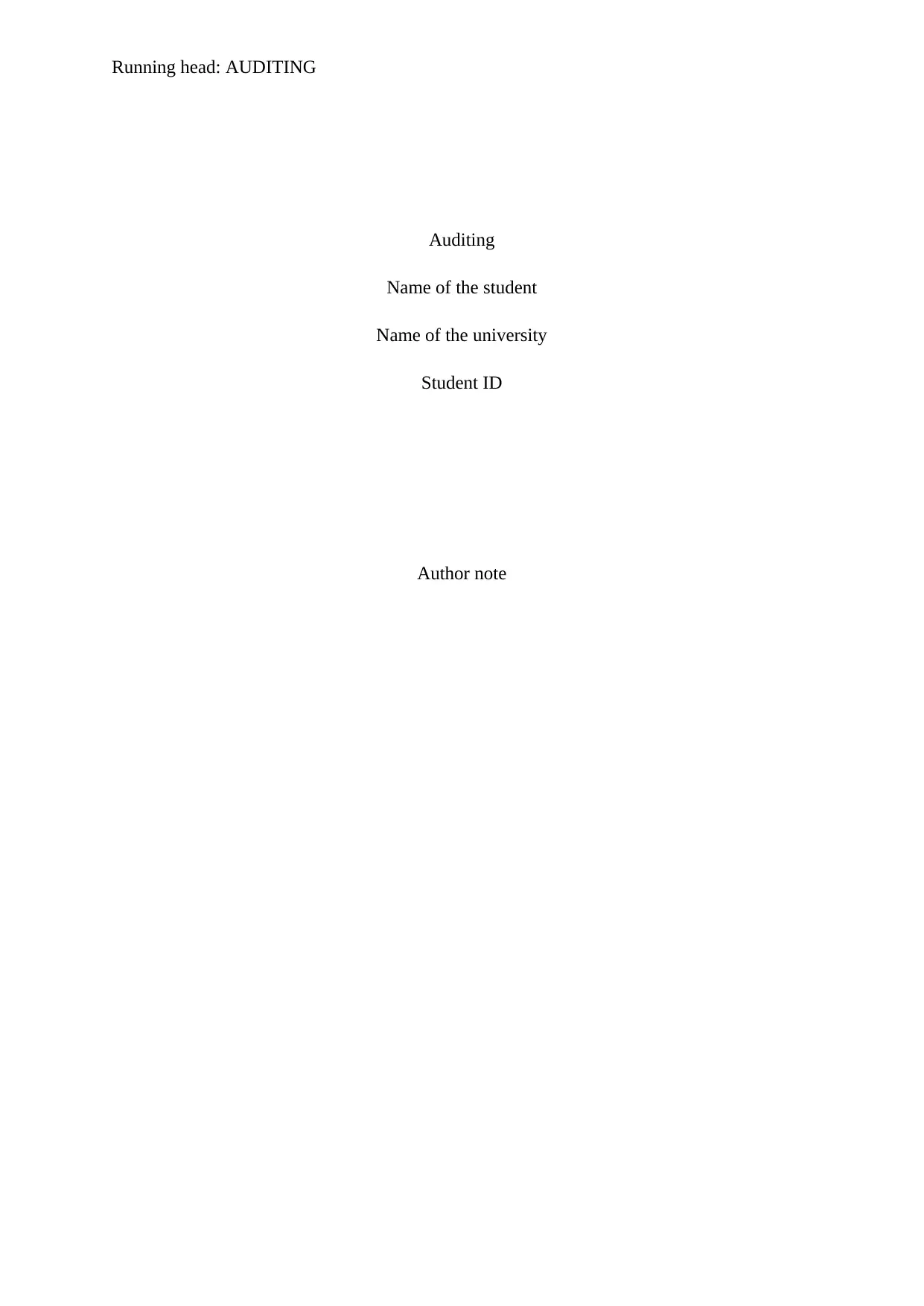
Running head: AUDITING
Auditing
Name of the student
Name of the university
Student ID
Author note
Auditing
Name of the student
Name of the university
Student ID
Author note
Paraphrase This Document
Need a fresh take? Get an instant paraphrase of this document with our AI Paraphraser

1AUDITING
Executive summary
This report is based on a real-life case study of an organization that have been collapsed due
to lack of adequate approaches of auditing. In this context, this report has analyzed the case
study of HIH Insurance Ltd that collapsed in the year 2001 due to presence of ineffective
auditing approaches and non-compliance with the auditing standards. The report has
specifically investigated the issue related to corporate governance, executive director, non-
compliance with the laws and use of aggressive accounting policies and misappropriation that
resulted in the downfall of the corporation. At last, it has presented recommendation deduced
from the overall analysis of the case of HIH Insurance Ltd in context of these issues for the
business corporations worldwide.
Executive summary
This report is based on a real-life case study of an organization that have been collapsed due
to lack of adequate approaches of auditing. In this context, this report has analyzed the case
study of HIH Insurance Ltd that collapsed in the year 2001 due to presence of ineffective
auditing approaches and non-compliance with the auditing standards. The report has
specifically investigated the issue related to corporate governance, executive director, non-
compliance with the laws and use of aggressive accounting policies and misappropriation that
resulted in the downfall of the corporation. At last, it has presented recommendation deduced
from the overall analysis of the case of HIH Insurance Ltd in context of these issues for the
business corporations worldwide.
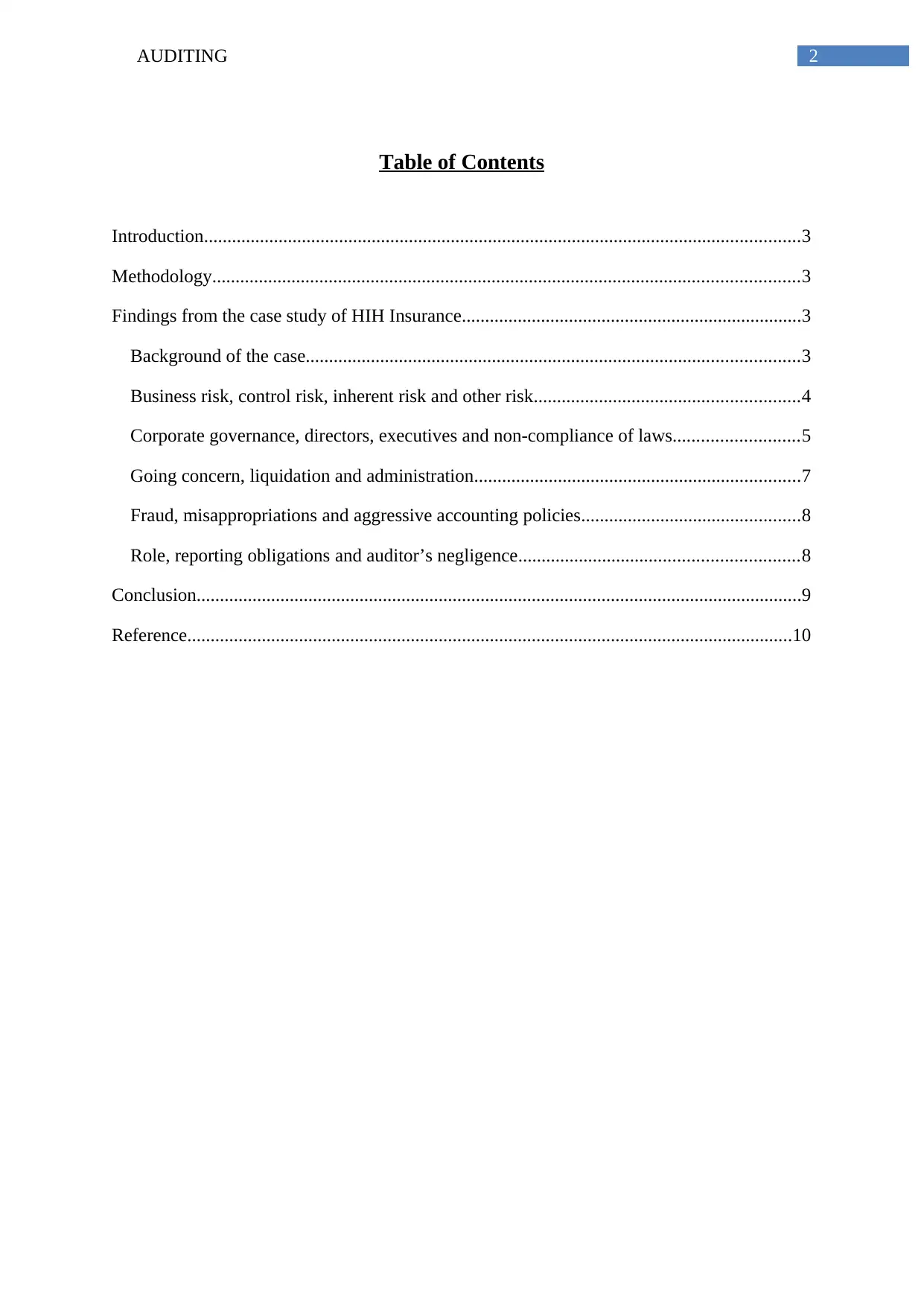
2AUDITING
Table of Contents
Introduction................................................................................................................................3
Methodology..............................................................................................................................3
Findings from the case study of HIH Insurance.........................................................................3
Background of the case..........................................................................................................3
Business risk, control risk, inherent risk and other risk.........................................................4
Corporate governance, directors, executives and non-compliance of laws...........................5
Going concern, liquidation and administration......................................................................7
Fraud, misappropriations and aggressive accounting policies...............................................8
Role, reporting obligations and auditor’s negligence............................................................8
Conclusion..................................................................................................................................9
Reference..................................................................................................................................10
Table of Contents
Introduction................................................................................................................................3
Methodology..............................................................................................................................3
Findings from the case study of HIH Insurance.........................................................................3
Background of the case..........................................................................................................3
Business risk, control risk, inherent risk and other risk.........................................................4
Corporate governance, directors, executives and non-compliance of laws...........................5
Going concern, liquidation and administration......................................................................7
Fraud, misappropriations and aggressive accounting policies...............................................8
Role, reporting obligations and auditor’s negligence............................................................8
Conclusion..................................................................................................................................9
Reference..................................................................................................................................10
⊘ This is a preview!⊘
Do you want full access?
Subscribe today to unlock all pages.

Trusted by 1+ million students worldwide
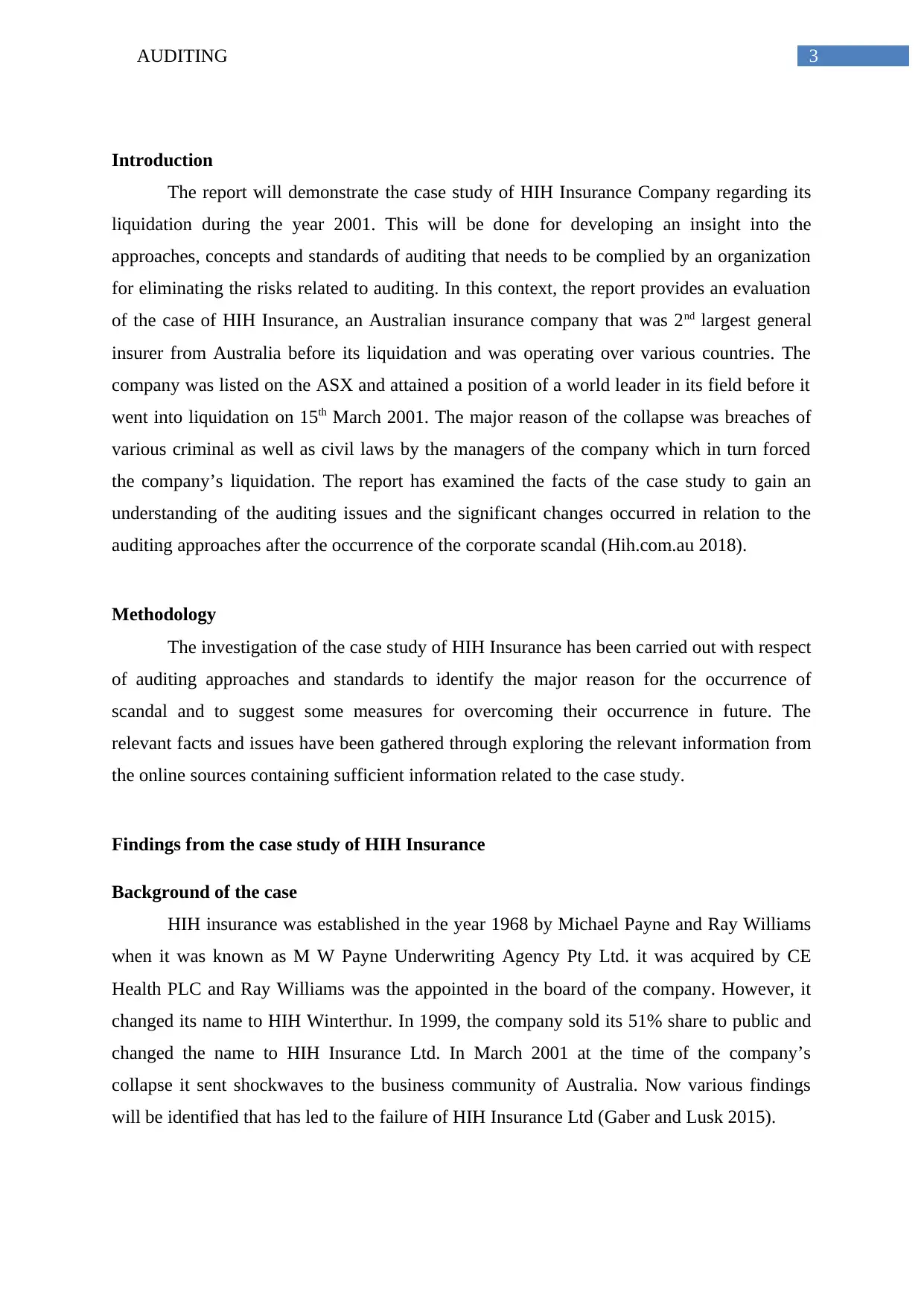
3AUDITING
Introduction
The report will demonstrate the case study of HIH Insurance Company regarding its
liquidation during the year 2001. This will be done for developing an insight into the
approaches, concepts and standards of auditing that needs to be complied by an organization
for eliminating the risks related to auditing. In this context, the report provides an evaluation
of the case of HIH Insurance, an Australian insurance company that was 2nd largest general
insurer from Australia before its liquidation and was operating over various countries. The
company was listed on the ASX and attained a position of a world leader in its field before it
went into liquidation on 15th March 2001. The major reason of the collapse was breaches of
various criminal as well as civil laws by the managers of the company which in turn forced
the company’s liquidation. The report has examined the facts of the case study to gain an
understanding of the auditing issues and the significant changes occurred in relation to the
auditing approaches after the occurrence of the corporate scandal (Hih.com.au 2018).
Methodology
The investigation of the case study of HIH Insurance has been carried out with respect
of auditing approaches and standards to identify the major reason for the occurrence of
scandal and to suggest some measures for overcoming their occurrence in future. The
relevant facts and issues have been gathered through exploring the relevant information from
the online sources containing sufficient information related to the case study.
Findings from the case study of HIH Insurance
Background of the case
HIH insurance was established in the year 1968 by Michael Payne and Ray Williams
when it was known as M W Payne Underwriting Agency Pty Ltd. it was acquired by CE
Health PLC and Ray Williams was the appointed in the board of the company. However, it
changed its name to HIH Winterthur. In 1999, the company sold its 51% share to public and
changed the name to HIH Insurance Ltd. In March 2001 at the time of the company’s
collapse it sent shockwaves to the business community of Australia. Now various findings
will be identified that has led to the failure of HIH Insurance Ltd (Gaber and Lusk 2015).
Introduction
The report will demonstrate the case study of HIH Insurance Company regarding its
liquidation during the year 2001. This will be done for developing an insight into the
approaches, concepts and standards of auditing that needs to be complied by an organization
for eliminating the risks related to auditing. In this context, the report provides an evaluation
of the case of HIH Insurance, an Australian insurance company that was 2nd largest general
insurer from Australia before its liquidation and was operating over various countries. The
company was listed on the ASX and attained a position of a world leader in its field before it
went into liquidation on 15th March 2001. The major reason of the collapse was breaches of
various criminal as well as civil laws by the managers of the company which in turn forced
the company’s liquidation. The report has examined the facts of the case study to gain an
understanding of the auditing issues and the significant changes occurred in relation to the
auditing approaches after the occurrence of the corporate scandal (Hih.com.au 2018).
Methodology
The investigation of the case study of HIH Insurance has been carried out with respect
of auditing approaches and standards to identify the major reason for the occurrence of
scandal and to suggest some measures for overcoming their occurrence in future. The
relevant facts and issues have been gathered through exploring the relevant information from
the online sources containing sufficient information related to the case study.
Findings from the case study of HIH Insurance
Background of the case
HIH insurance was established in the year 1968 by Michael Payne and Ray Williams
when it was known as M W Payne Underwriting Agency Pty Ltd. it was acquired by CE
Health PLC and Ray Williams was the appointed in the board of the company. However, it
changed its name to HIH Winterthur. In 1999, the company sold its 51% share to public and
changed the name to HIH Insurance Ltd. In March 2001 at the time of the company’s
collapse it sent shockwaves to the business community of Australia. Now various findings
will be identified that has led to the failure of HIH Insurance Ltd (Gaber and Lusk 2015).
Paraphrase This Document
Need a fresh take? Get an instant paraphrase of this document with our AI Paraphraser
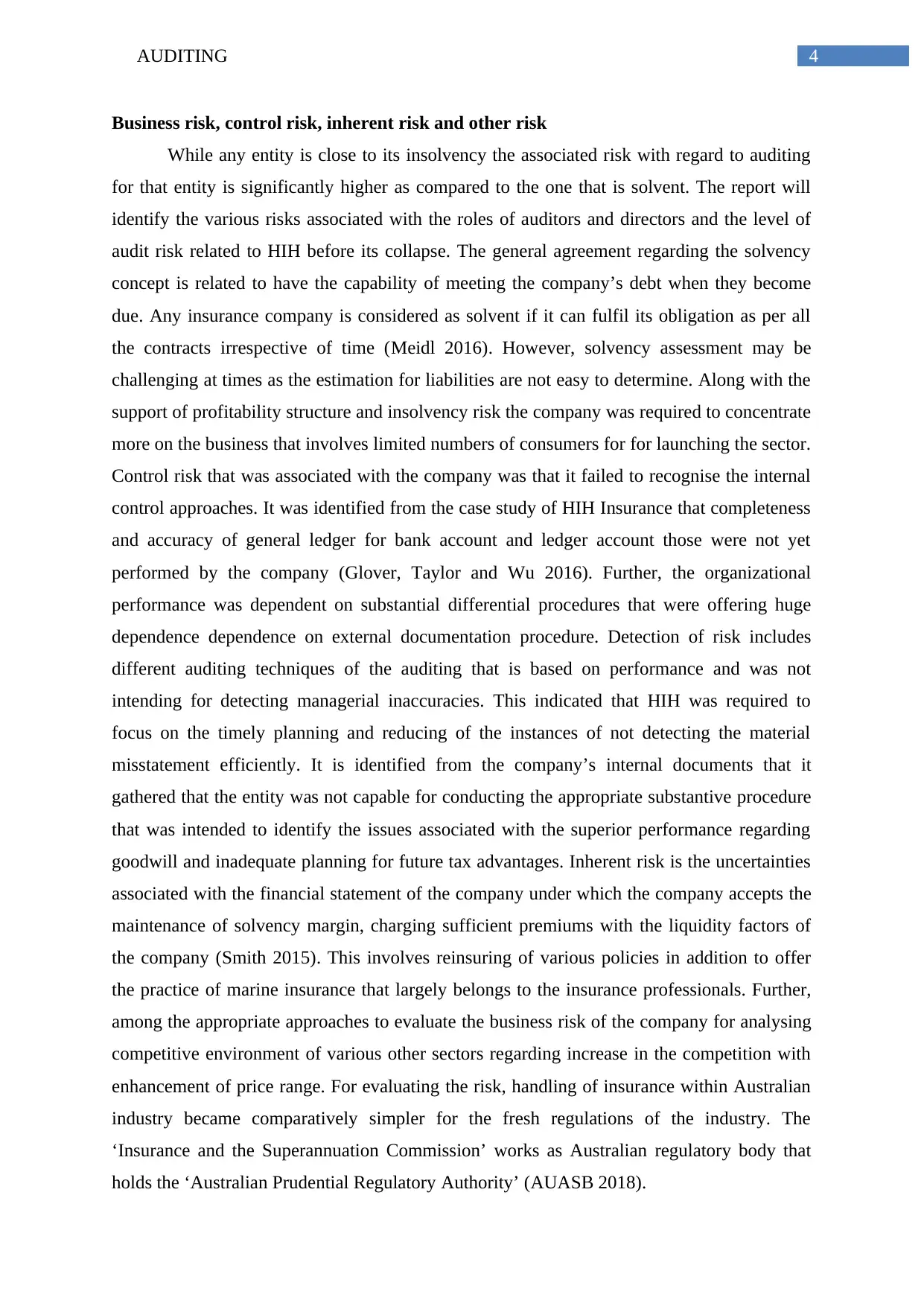
4AUDITING
Business risk, control risk, inherent risk and other risk
While any entity is close to its insolvency the associated risk with regard to auditing
for that entity is significantly higher as compared to the one that is solvent. The report will
identify the various risks associated with the roles of auditors and directors and the level of
audit risk related to HIH before its collapse. The general agreement regarding the solvency
concept is related to have the capability of meeting the company’s debt when they become
due. Any insurance company is considered as solvent if it can fulfil its obligation as per all
the contracts irrespective of time (Meidl 2016). However, solvency assessment may be
challenging at times as the estimation for liabilities are not easy to determine. Along with the
support of profitability structure and insolvency risk the company was required to concentrate
more on the business that involves limited numbers of consumers for for launching the sector.
Control risk that was associated with the company was that it failed to recognise the internal
control approaches. It was identified from the case study of HIH Insurance that completeness
and accuracy of general ledger for bank account and ledger account those were not yet
performed by the company (Glover, Taylor and Wu 2016). Further, the organizational
performance was dependent on substantial differential procedures that were offering huge
dependence dependence on external documentation procedure. Detection of risk includes
different auditing techniques of the auditing that is based on performance and was not
intending for detecting managerial inaccuracies. This indicated that HIH was required to
focus on the timely planning and reducing of the instances of not detecting the material
misstatement efficiently. It is identified from the company’s internal documents that it
gathered that the entity was not capable for conducting the appropriate substantive procedure
that was intended to identify the issues associated with the superior performance regarding
goodwill and inadequate planning for future tax advantages. Inherent risk is the uncertainties
associated with the financial statement of the company under which the company accepts the
maintenance of solvency margin, charging sufficient premiums with the liquidity factors of
the company (Smith 2015). This involves reinsuring of various policies in addition to offer
the practice of marine insurance that largely belongs to the insurance professionals. Further,
among the appropriate approaches to evaluate the business risk of the company for analysing
competitive environment of various other sectors regarding increase in the competition with
enhancement of price range. For evaluating the risk, handling of insurance within Australian
industry became comparatively simpler for the fresh regulations of the industry. The
‘Insurance and the Superannuation Commission’ works as Australian regulatory body that
holds the ‘Australian Prudential Regulatory Authority’ (AUASB 2018).
Business risk, control risk, inherent risk and other risk
While any entity is close to its insolvency the associated risk with regard to auditing
for that entity is significantly higher as compared to the one that is solvent. The report will
identify the various risks associated with the roles of auditors and directors and the level of
audit risk related to HIH before its collapse. The general agreement regarding the solvency
concept is related to have the capability of meeting the company’s debt when they become
due. Any insurance company is considered as solvent if it can fulfil its obligation as per all
the contracts irrespective of time (Meidl 2016). However, solvency assessment may be
challenging at times as the estimation for liabilities are not easy to determine. Along with the
support of profitability structure and insolvency risk the company was required to concentrate
more on the business that involves limited numbers of consumers for for launching the sector.
Control risk that was associated with the company was that it failed to recognise the internal
control approaches. It was identified from the case study of HIH Insurance that completeness
and accuracy of general ledger for bank account and ledger account those were not yet
performed by the company (Glover, Taylor and Wu 2016). Further, the organizational
performance was dependent on substantial differential procedures that were offering huge
dependence dependence on external documentation procedure. Detection of risk includes
different auditing techniques of the auditing that is based on performance and was not
intending for detecting managerial inaccuracies. This indicated that HIH was required to
focus on the timely planning and reducing of the instances of not detecting the material
misstatement efficiently. It is identified from the company’s internal documents that it
gathered that the entity was not capable for conducting the appropriate substantive procedure
that was intended to identify the issues associated with the superior performance regarding
goodwill and inadequate planning for future tax advantages. Inherent risk is the uncertainties
associated with the financial statement of the company under which the company accepts the
maintenance of solvency margin, charging sufficient premiums with the liquidity factors of
the company (Smith 2015). This involves reinsuring of various policies in addition to offer
the practice of marine insurance that largely belongs to the insurance professionals. Further,
among the appropriate approaches to evaluate the business risk of the company for analysing
competitive environment of various other sectors regarding increase in the competition with
enhancement of price range. For evaluating the risk, handling of insurance within Australian
industry became comparatively simpler for the fresh regulations of the industry. The
‘Insurance and the Superannuation Commission’ works as Australian regulatory body that
holds the ‘Australian Prudential Regulatory Authority’ (AUASB 2018).
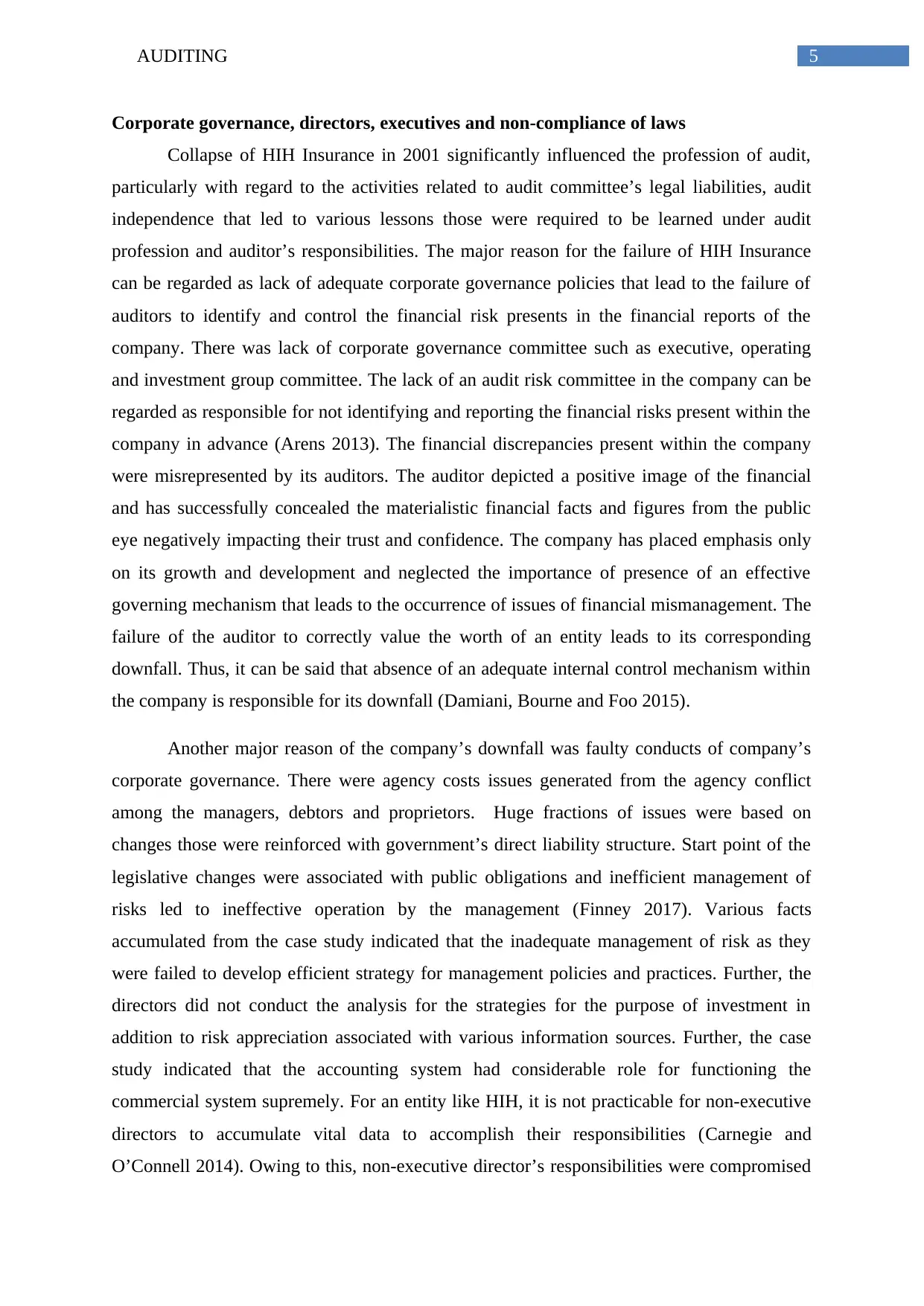
5AUDITING
Corporate governance, directors, executives and non-compliance of laws
Collapse of HIH Insurance in 2001 significantly influenced the profession of audit,
particularly with regard to the activities related to audit committee’s legal liabilities, audit
independence that led to various lessons those were required to be learned under audit
profession and auditor’s responsibilities. The major reason for the failure of HIH Insurance
can be regarded as lack of adequate corporate governance policies that lead to the failure of
auditors to identify and control the financial risk presents in the financial reports of the
company. There was lack of corporate governance committee such as executive, operating
and investment group committee. The lack of an audit risk committee in the company can be
regarded as responsible for not identifying and reporting the financial risks present within the
company in advance (Arens 2013). The financial discrepancies present within the company
were misrepresented by its auditors. The auditor depicted a positive image of the financial
and has successfully concealed the materialistic financial facts and figures from the public
eye negatively impacting their trust and confidence. The company has placed emphasis only
on its growth and development and neglected the importance of presence of an effective
governing mechanism that leads to the occurrence of issues of financial mismanagement. The
failure of the auditor to correctly value the worth of an entity leads to its corresponding
downfall. Thus, it can be said that absence of an adequate internal control mechanism within
the company is responsible for its downfall (Damiani, Bourne and Foo 2015).
Another major reason of the company’s downfall was faulty conducts of company’s
corporate governance. There were agency costs issues generated from the agency conflict
among the managers, debtors and proprietors. Huge fractions of issues were based on
changes those were reinforced with government’s direct liability structure. Start point of the
legislative changes were associated with public obligations and inefficient management of
risks led to ineffective operation by the management (Finney 2017). Various facts
accumulated from the case study indicated that the inadequate management of risk as they
were failed to develop efficient strategy for management policies and practices. Further, the
directors did not conduct the analysis for the strategies for the purpose of investment in
addition to risk appreciation associated with various information sources. Further, the case
study indicated that the accounting system had considerable role for functioning the
commercial system supremely. For an entity like HIH, it is not practicable for non-executive
directors to accumulate vital data to accomplish their responsibilities (Carnegie and
O’Connell 2014). Owing to this, non-executive director’s responsibilities were compromised
Corporate governance, directors, executives and non-compliance of laws
Collapse of HIH Insurance in 2001 significantly influenced the profession of audit,
particularly with regard to the activities related to audit committee’s legal liabilities, audit
independence that led to various lessons those were required to be learned under audit
profession and auditor’s responsibilities. The major reason for the failure of HIH Insurance
can be regarded as lack of adequate corporate governance policies that lead to the failure of
auditors to identify and control the financial risk presents in the financial reports of the
company. There was lack of corporate governance committee such as executive, operating
and investment group committee. The lack of an audit risk committee in the company can be
regarded as responsible for not identifying and reporting the financial risks present within the
company in advance (Arens 2013). The financial discrepancies present within the company
were misrepresented by its auditors. The auditor depicted a positive image of the financial
and has successfully concealed the materialistic financial facts and figures from the public
eye negatively impacting their trust and confidence. The company has placed emphasis only
on its growth and development and neglected the importance of presence of an effective
governing mechanism that leads to the occurrence of issues of financial mismanagement. The
failure of the auditor to correctly value the worth of an entity leads to its corresponding
downfall. Thus, it can be said that absence of an adequate internal control mechanism within
the company is responsible for its downfall (Damiani, Bourne and Foo 2015).
Another major reason of the company’s downfall was faulty conducts of company’s
corporate governance. There were agency costs issues generated from the agency conflict
among the managers, debtors and proprietors. Huge fractions of issues were based on
changes those were reinforced with government’s direct liability structure. Start point of the
legislative changes were associated with public obligations and inefficient management of
risks led to ineffective operation by the management (Finney 2017). Various facts
accumulated from the case study indicated that the inadequate management of risk as they
were failed to develop efficient strategy for management policies and practices. Further, the
directors did not conduct the analysis for the strategies for the purpose of investment in
addition to risk appreciation associated with various information sources. Further, the case
study indicated that the accounting system had considerable role for functioning the
commercial system supremely. For an entity like HIH, it is not practicable for non-executive
directors to accumulate vital data to accomplish their responsibilities (Carnegie and
O’Connell 2014). Owing to this, non-executive director’s responsibilities were compromised
⊘ This is a preview!⊘
Do you want full access?
Subscribe today to unlock all pages.

Trusted by 1+ million students worldwide
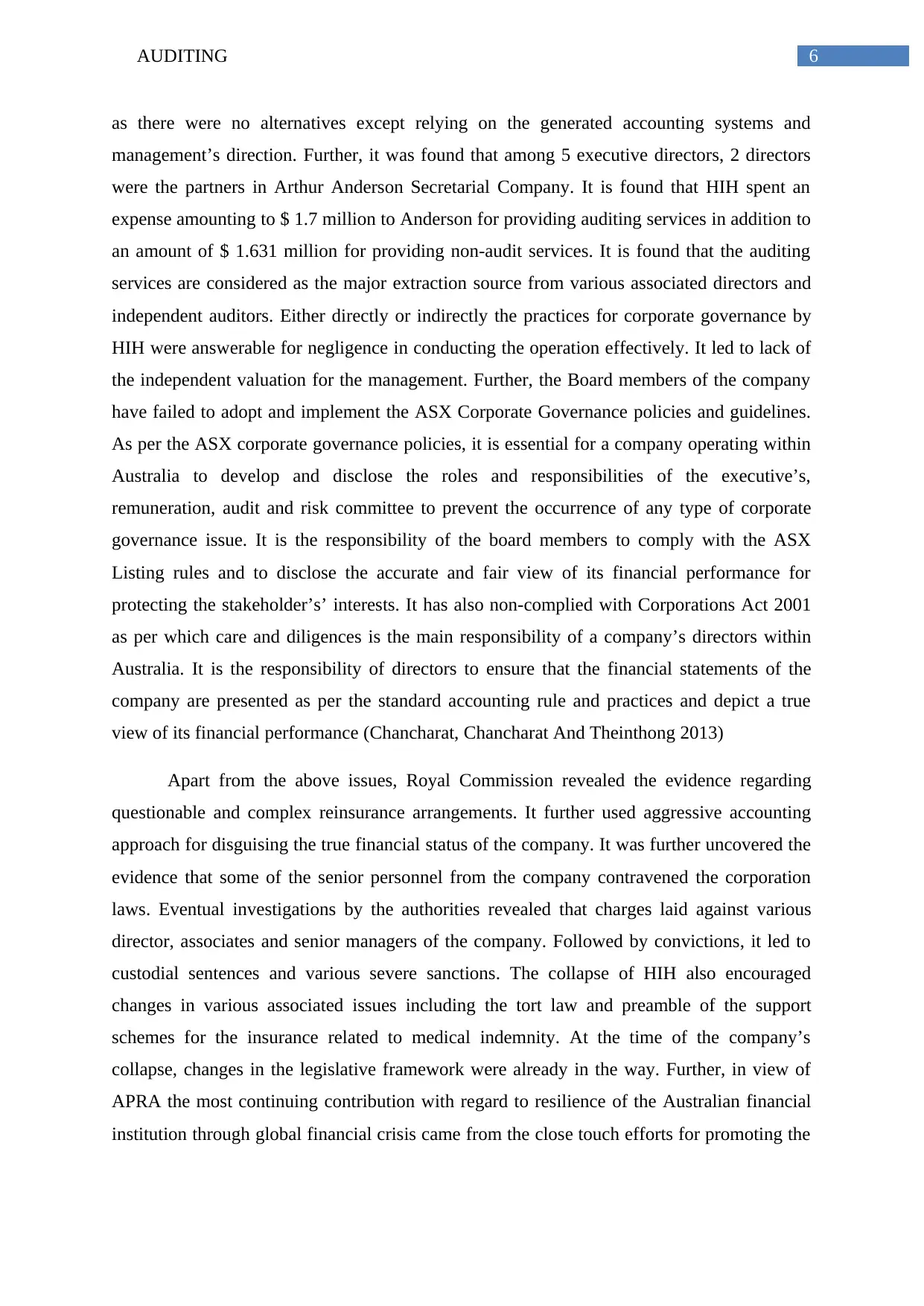
6AUDITING
as there were no alternatives except relying on the generated accounting systems and
management’s direction. Further, it was found that among 5 executive directors, 2 directors
were the partners in Arthur Anderson Secretarial Company. It is found that HIH spent an
expense amounting to $ 1.7 million to Anderson for providing auditing services in addition to
an amount of $ 1.631 million for providing non-audit services. It is found that the auditing
services are considered as the major extraction source from various associated directors and
independent auditors. Either directly or indirectly the practices for corporate governance by
HIH were answerable for negligence in conducting the operation effectively. It led to lack of
the independent valuation for the management. Further, the Board members of the company
have failed to adopt and implement the ASX Corporate Governance policies and guidelines.
As per the ASX corporate governance policies, it is essential for a company operating within
Australia to develop and disclose the roles and responsibilities of the executive’s,
remuneration, audit and risk committee to prevent the occurrence of any type of corporate
governance issue. It is the responsibility of the board members to comply with the ASX
Listing rules and to disclose the accurate and fair view of its financial performance for
protecting the stakeholder’s’ interests. It has also non-complied with Corporations Act 2001
as per which care and diligences is the main responsibility of a company’s directors within
Australia. It is the responsibility of directors to ensure that the financial statements of the
company are presented as per the standard accounting rule and practices and depict a true
view of its financial performance (Chancharat, Chancharat And Theinthong 2013)
Apart from the above issues, Royal Commission revealed the evidence regarding
questionable and complex reinsurance arrangements. It further used aggressive accounting
approach for disguising the true financial status of the company. It was further uncovered the
evidence that some of the senior personnel from the company contravened the corporation
laws. Eventual investigations by the authorities revealed that charges laid against various
director, associates and senior managers of the company. Followed by convictions, it led to
custodial sentences and various severe sanctions. The collapse of HIH also encouraged
changes in various associated issues including the tort law and preamble of the support
schemes for the insurance related to medical indemnity. At the time of the company’s
collapse, changes in the legislative framework were already in the way. Further, in view of
APRA the most continuing contribution with regard to resilience of the Australian financial
institution through global financial crisis came from the close touch efforts for promoting the
as there were no alternatives except relying on the generated accounting systems and
management’s direction. Further, it was found that among 5 executive directors, 2 directors
were the partners in Arthur Anderson Secretarial Company. It is found that HIH spent an
expense amounting to $ 1.7 million to Anderson for providing auditing services in addition to
an amount of $ 1.631 million for providing non-audit services. It is found that the auditing
services are considered as the major extraction source from various associated directors and
independent auditors. Either directly or indirectly the practices for corporate governance by
HIH were answerable for negligence in conducting the operation effectively. It led to lack of
the independent valuation for the management. Further, the Board members of the company
have failed to adopt and implement the ASX Corporate Governance policies and guidelines.
As per the ASX corporate governance policies, it is essential for a company operating within
Australia to develop and disclose the roles and responsibilities of the executive’s,
remuneration, audit and risk committee to prevent the occurrence of any type of corporate
governance issue. It is the responsibility of the board members to comply with the ASX
Listing rules and to disclose the accurate and fair view of its financial performance for
protecting the stakeholder’s’ interests. It has also non-complied with Corporations Act 2001
as per which care and diligences is the main responsibility of a company’s directors within
Australia. It is the responsibility of directors to ensure that the financial statements of the
company are presented as per the standard accounting rule and practices and depict a true
view of its financial performance (Chancharat, Chancharat And Theinthong 2013)
Apart from the above issues, Royal Commission revealed the evidence regarding
questionable and complex reinsurance arrangements. It further used aggressive accounting
approach for disguising the true financial status of the company. It was further uncovered the
evidence that some of the senior personnel from the company contravened the corporation
laws. Eventual investigations by the authorities revealed that charges laid against various
director, associates and senior managers of the company. Followed by convictions, it led to
custodial sentences and various severe sanctions. The collapse of HIH also encouraged
changes in various associated issues including the tort law and preamble of the support
schemes for the insurance related to medical indemnity. At the time of the company’s
collapse, changes in the legislative framework were already in the way. Further, in view of
APRA the most continuing contribution with regard to resilience of the Australian financial
institution through global financial crisis came from the close touch efforts for promoting the
Paraphrase This Document
Need a fresh take? Get an instant paraphrase of this document with our AI Paraphraser
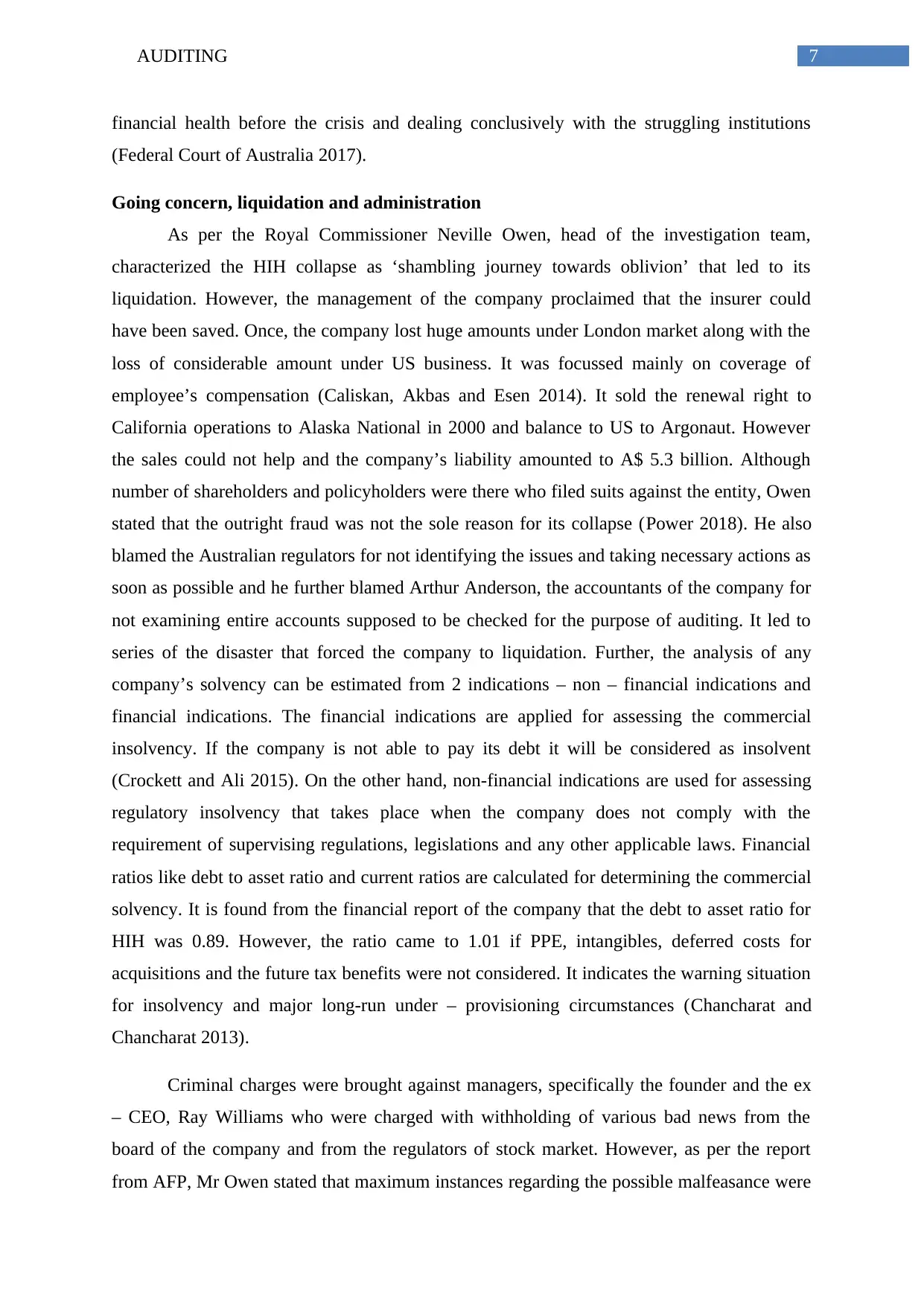
7AUDITING
financial health before the crisis and dealing conclusively with the struggling institutions
(Federal Court of Australia 2017).
Going concern, liquidation and administration
As per the Royal Commissioner Neville Owen, head of the investigation team,
characterized the HIH collapse as ‘shambling journey towards oblivion’ that led to its
liquidation. However, the management of the company proclaimed that the insurer could
have been saved. Once, the company lost huge amounts under London market along with the
loss of considerable amount under US business. It was focussed mainly on coverage of
employee’s compensation (Caliskan, Akbas and Esen 2014). It sold the renewal right to
California operations to Alaska National in 2000 and balance to US to Argonaut. However
the sales could not help and the company’s liability amounted to A$ 5.3 billion. Although
number of shareholders and policyholders were there who filed suits against the entity, Owen
stated that the outright fraud was not the sole reason for its collapse (Power 2018). He also
blamed the Australian regulators for not identifying the issues and taking necessary actions as
soon as possible and he further blamed Arthur Anderson, the accountants of the company for
not examining entire accounts supposed to be checked for the purpose of auditing. It led to
series of the disaster that forced the company to liquidation. Further, the analysis of any
company’s solvency can be estimated from 2 indications – non – financial indications and
financial indications. The financial indications are applied for assessing the commercial
insolvency. If the company is not able to pay its debt it will be considered as insolvent
(Crockett and Ali 2015). On the other hand, non-financial indications are used for assessing
regulatory insolvency that takes place when the company does not comply with the
requirement of supervising regulations, legislations and any other applicable laws. Financial
ratios like debt to asset ratio and current ratios are calculated for determining the commercial
solvency. It is found from the financial report of the company that the debt to asset ratio for
HIH was 0.89. However, the ratio came to 1.01 if PPE, intangibles, deferred costs for
acquisitions and the future tax benefits were not considered. It indicates the warning situation
for insolvency and major long-run under – provisioning circumstances (Chancharat and
Chancharat 2013).
Criminal charges were brought against managers, specifically the founder and the ex
– CEO, Ray Williams who were charged with withholding of various bad news from the
board of the company and from the regulators of stock market. However, as per the report
from AFP, Mr Owen stated that maximum instances regarding the possible malfeasance were
financial health before the crisis and dealing conclusively with the struggling institutions
(Federal Court of Australia 2017).
Going concern, liquidation and administration
As per the Royal Commissioner Neville Owen, head of the investigation team,
characterized the HIH collapse as ‘shambling journey towards oblivion’ that led to its
liquidation. However, the management of the company proclaimed that the insurer could
have been saved. Once, the company lost huge amounts under London market along with the
loss of considerable amount under US business. It was focussed mainly on coverage of
employee’s compensation (Caliskan, Akbas and Esen 2014). It sold the renewal right to
California operations to Alaska National in 2000 and balance to US to Argonaut. However
the sales could not help and the company’s liability amounted to A$ 5.3 billion. Although
number of shareholders and policyholders were there who filed suits against the entity, Owen
stated that the outright fraud was not the sole reason for its collapse (Power 2018). He also
blamed the Australian regulators for not identifying the issues and taking necessary actions as
soon as possible and he further blamed Arthur Anderson, the accountants of the company for
not examining entire accounts supposed to be checked for the purpose of auditing. It led to
series of the disaster that forced the company to liquidation. Further, the analysis of any
company’s solvency can be estimated from 2 indications – non – financial indications and
financial indications. The financial indications are applied for assessing the commercial
insolvency. If the company is not able to pay its debt it will be considered as insolvent
(Crockett and Ali 2015). On the other hand, non-financial indications are used for assessing
regulatory insolvency that takes place when the company does not comply with the
requirement of supervising regulations, legislations and any other applicable laws. Financial
ratios like debt to asset ratio and current ratios are calculated for determining the commercial
solvency. It is found from the financial report of the company that the debt to asset ratio for
HIH was 0.89. However, the ratio came to 1.01 if PPE, intangibles, deferred costs for
acquisitions and the future tax benefits were not considered. It indicates the warning situation
for insolvency and major long-run under – provisioning circumstances (Chancharat and
Chancharat 2013).
Criminal charges were brought against managers, specifically the founder and the ex
– CEO, Ray Williams who were charged with withholding of various bad news from the
board of the company and from the regulators of stock market. However, as per the report
from AFP, Mr Owen stated that maximum instances regarding the possible malfeasance were
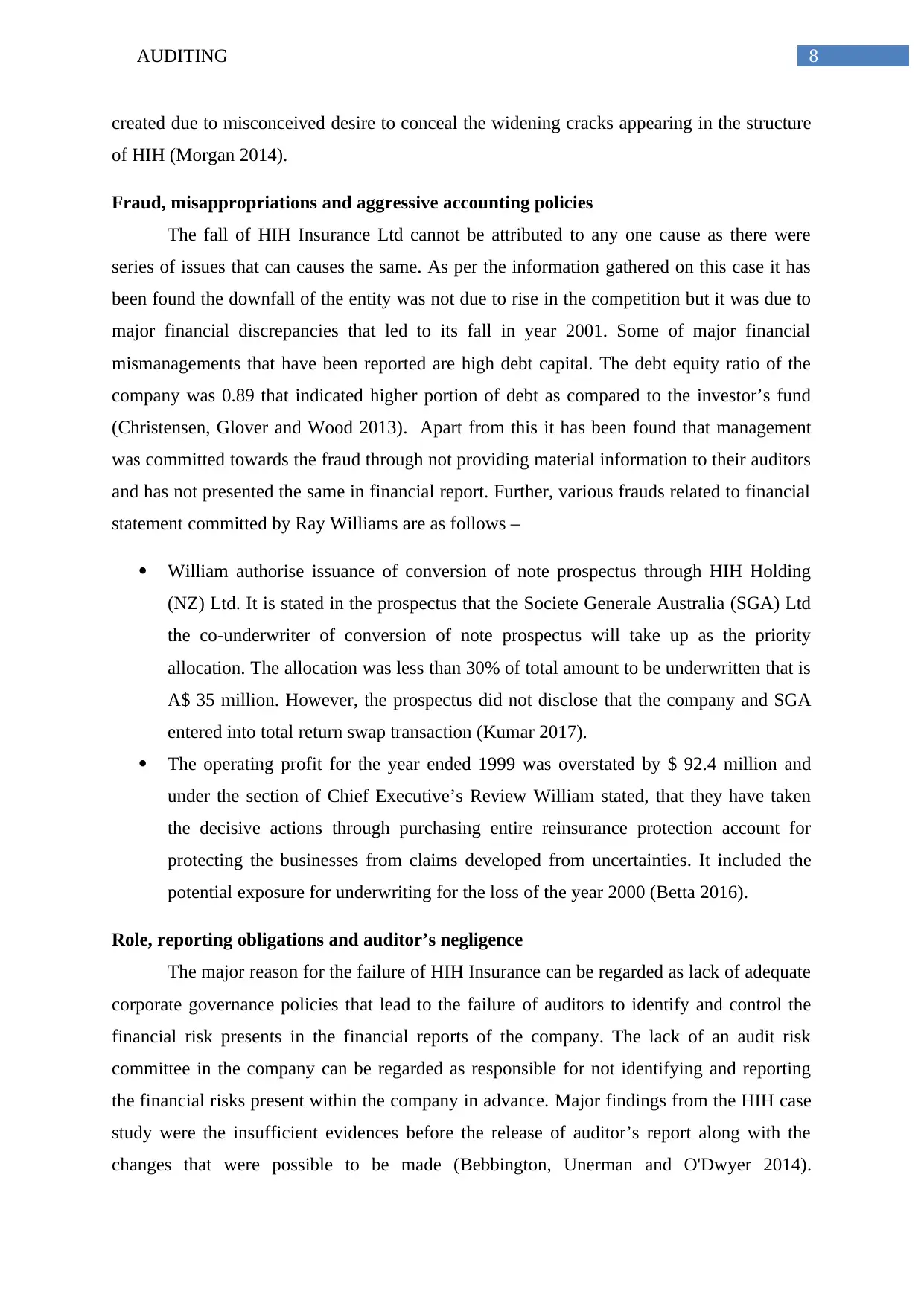
8AUDITING
created due to misconceived desire to conceal the widening cracks appearing in the structure
of HIH (Morgan 2014).
Fraud, misappropriations and aggressive accounting policies
The fall of HIH Insurance Ltd cannot be attributed to any one cause as there were
series of issues that can causes the same. As per the information gathered on this case it has
been found the downfall of the entity was not due to rise in the competition but it was due to
major financial discrepancies that led to its fall in year 2001. Some of major financial
mismanagements that have been reported are high debt capital. The debt equity ratio of the
company was 0.89 that indicated higher portion of debt as compared to the investor’s fund
(Christensen, Glover and Wood 2013). Apart from this it has been found that management
was committed towards the fraud through not providing material information to their auditors
and has not presented the same in financial report. Further, various frauds related to financial
statement committed by Ray Williams are as follows –
William authorise issuance of conversion of note prospectus through HIH Holding
(NZ) Ltd. It is stated in the prospectus that the Societe Generale Australia (SGA) Ltd
the co-underwriter of conversion of note prospectus will take up as the priority
allocation. The allocation was less than 30% of total amount to be underwritten that is
A$ 35 million. However, the prospectus did not disclose that the company and SGA
entered into total return swap transaction (Kumar 2017).
The operating profit for the year ended 1999 was overstated by $ 92.4 million and
under the section of Chief Executive’s Review William stated, that they have taken
the decisive actions through purchasing entire reinsurance protection account for
protecting the businesses from claims developed from uncertainties. It included the
potential exposure for underwriting for the loss of the year 2000 (Betta 2016).
Role, reporting obligations and auditor’s negligence
The major reason for the failure of HIH Insurance can be regarded as lack of adequate
corporate governance policies that lead to the failure of auditors to identify and control the
financial risk presents in the financial reports of the company. The lack of an audit risk
committee in the company can be regarded as responsible for not identifying and reporting
the financial risks present within the company in advance. Major findings from the HIH case
study were the insufficient evidences before the release of auditor’s report along with the
changes that were possible to be made (Bebbington, Unerman and O'Dwyer 2014).
created due to misconceived desire to conceal the widening cracks appearing in the structure
of HIH (Morgan 2014).
Fraud, misappropriations and aggressive accounting policies
The fall of HIH Insurance Ltd cannot be attributed to any one cause as there were
series of issues that can causes the same. As per the information gathered on this case it has
been found the downfall of the entity was not due to rise in the competition but it was due to
major financial discrepancies that led to its fall in year 2001. Some of major financial
mismanagements that have been reported are high debt capital. The debt equity ratio of the
company was 0.89 that indicated higher portion of debt as compared to the investor’s fund
(Christensen, Glover and Wood 2013). Apart from this it has been found that management
was committed towards the fraud through not providing material information to their auditors
and has not presented the same in financial report. Further, various frauds related to financial
statement committed by Ray Williams are as follows –
William authorise issuance of conversion of note prospectus through HIH Holding
(NZ) Ltd. It is stated in the prospectus that the Societe Generale Australia (SGA) Ltd
the co-underwriter of conversion of note prospectus will take up as the priority
allocation. The allocation was less than 30% of total amount to be underwritten that is
A$ 35 million. However, the prospectus did not disclose that the company and SGA
entered into total return swap transaction (Kumar 2017).
The operating profit for the year ended 1999 was overstated by $ 92.4 million and
under the section of Chief Executive’s Review William stated, that they have taken
the decisive actions through purchasing entire reinsurance protection account for
protecting the businesses from claims developed from uncertainties. It included the
potential exposure for underwriting for the loss of the year 2000 (Betta 2016).
Role, reporting obligations and auditor’s negligence
The major reason for the failure of HIH Insurance can be regarded as lack of adequate
corporate governance policies that lead to the failure of auditors to identify and control the
financial risk presents in the financial reports of the company. The lack of an audit risk
committee in the company can be regarded as responsible for not identifying and reporting
the financial risks present within the company in advance. Major findings from the HIH case
study were the insufficient evidences before the release of auditor’s report along with the
changes that were possible to be made (Bebbington, Unerman and O'Dwyer 2014).
⊘ This is a preview!⊘
Do you want full access?
Subscribe today to unlock all pages.

Trusted by 1+ million students worldwide
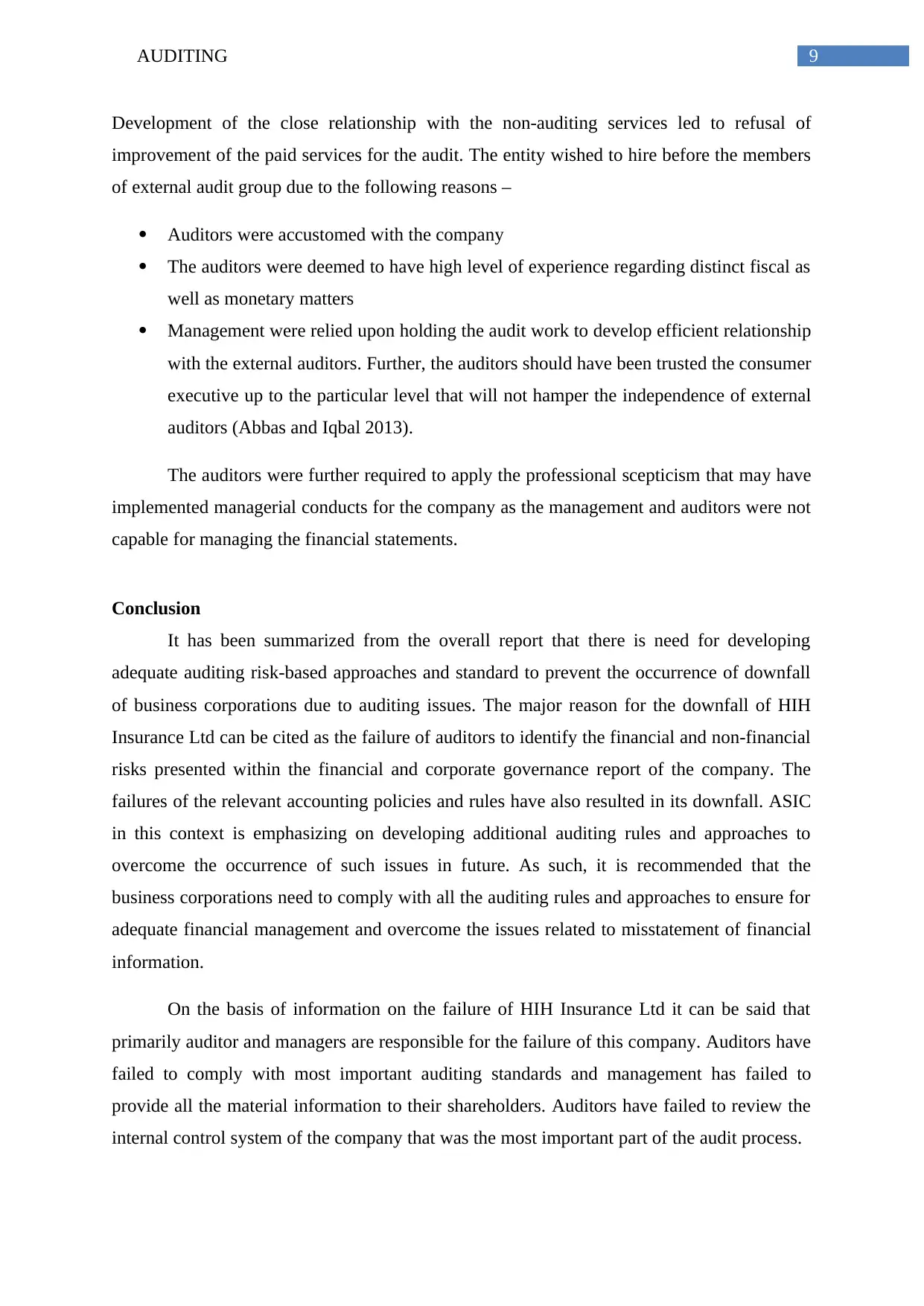
9AUDITING
Development of the close relationship with the non-auditing services led to refusal of
improvement of the paid services for the audit. The entity wished to hire before the members
of external audit group due to the following reasons –
Auditors were accustomed with the company
The auditors were deemed to have high level of experience regarding distinct fiscal as
well as monetary matters
Management were relied upon holding the audit work to develop efficient relationship
with the external auditors. Further, the auditors should have been trusted the consumer
executive up to the particular level that will not hamper the independence of external
auditors (Abbas and Iqbal 2013).
The auditors were further required to apply the professional scepticism that may have
implemented managerial conducts for the company as the management and auditors were not
capable for managing the financial statements.
Conclusion
It has been summarized from the overall report that there is need for developing
adequate auditing risk-based approaches and standard to prevent the occurrence of downfall
of business corporations due to auditing issues. The major reason for the downfall of HIH
Insurance Ltd can be cited as the failure of auditors to identify the financial and non-financial
risks presented within the financial and corporate governance report of the company. The
failures of the relevant accounting policies and rules have also resulted in its downfall. ASIC
in this context is emphasizing on developing additional auditing rules and approaches to
overcome the occurrence of such issues in future. As such, it is recommended that the
business corporations need to comply with all the auditing rules and approaches to ensure for
adequate financial management and overcome the issues related to misstatement of financial
information.
On the basis of information on the failure of HIH Insurance Ltd it can be said that
primarily auditor and managers are responsible for the failure of this company. Auditors have
failed to comply with most important auditing standards and management has failed to
provide all the material information to their shareholders. Auditors have failed to review the
internal control system of the company that was the most important part of the audit process.
Development of the close relationship with the non-auditing services led to refusal of
improvement of the paid services for the audit. The entity wished to hire before the members
of external audit group due to the following reasons –
Auditors were accustomed with the company
The auditors were deemed to have high level of experience regarding distinct fiscal as
well as monetary matters
Management were relied upon holding the audit work to develop efficient relationship
with the external auditors. Further, the auditors should have been trusted the consumer
executive up to the particular level that will not hamper the independence of external
auditors (Abbas and Iqbal 2013).
The auditors were further required to apply the professional scepticism that may have
implemented managerial conducts for the company as the management and auditors were not
capable for managing the financial statements.
Conclusion
It has been summarized from the overall report that there is need for developing
adequate auditing risk-based approaches and standard to prevent the occurrence of downfall
of business corporations due to auditing issues. The major reason for the downfall of HIH
Insurance Ltd can be cited as the failure of auditors to identify the financial and non-financial
risks presented within the financial and corporate governance report of the company. The
failures of the relevant accounting policies and rules have also resulted in its downfall. ASIC
in this context is emphasizing on developing additional auditing rules and approaches to
overcome the occurrence of such issues in future. As such, it is recommended that the
business corporations need to comply with all the auditing rules and approaches to ensure for
adequate financial management and overcome the issues related to misstatement of financial
information.
On the basis of information on the failure of HIH Insurance Ltd it can be said that
primarily auditor and managers are responsible for the failure of this company. Auditors have
failed to comply with most important auditing standards and management has failed to
provide all the material information to their shareholders. Auditors have failed to review the
internal control system of the company that was the most important part of the audit process.
Paraphrase This Document
Need a fresh take? Get an instant paraphrase of this document with our AI Paraphraser
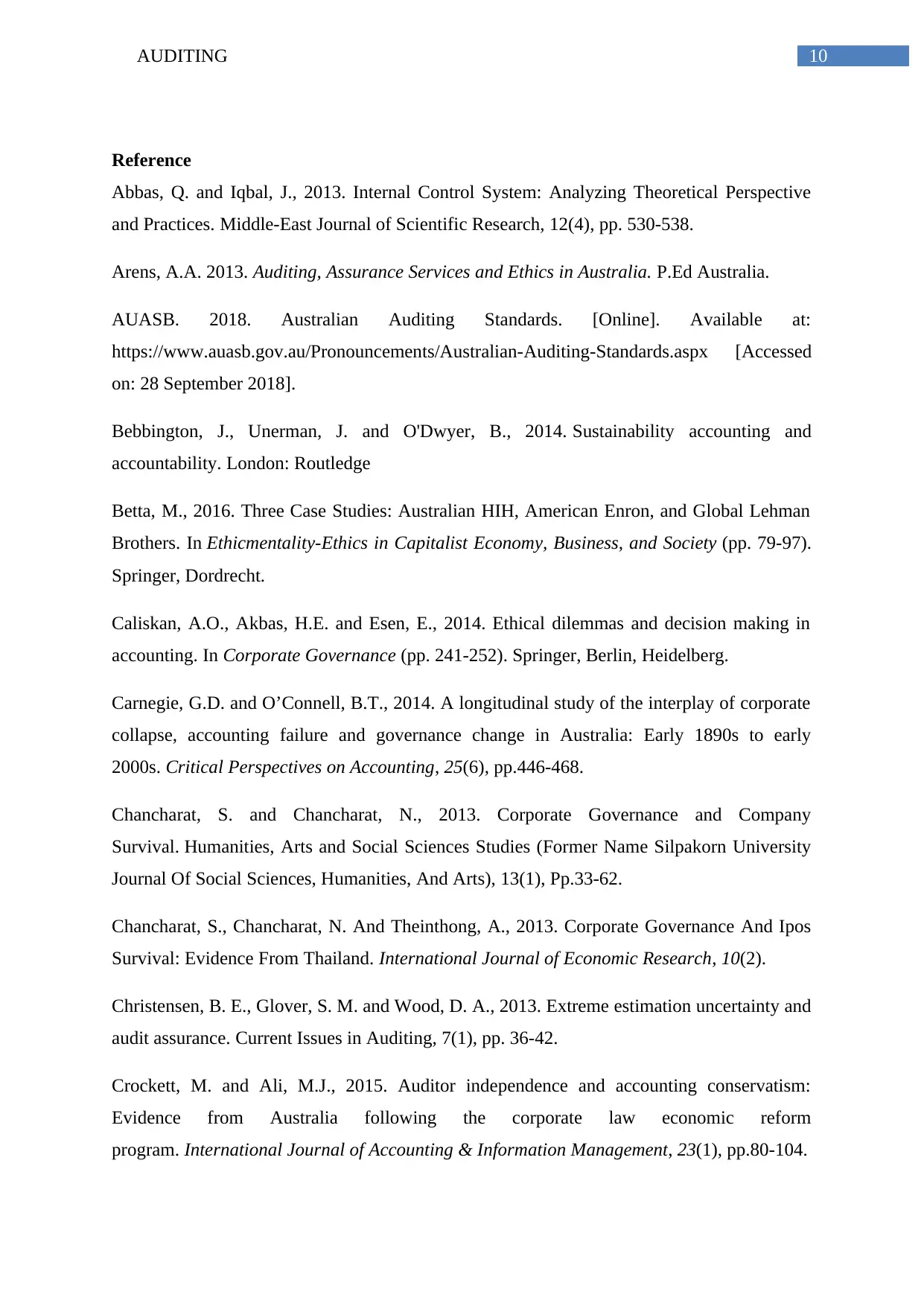
10AUDITING
Reference
Abbas, Q. and Iqbal, J., 2013. Internal Control System: Analyzing Theoretical Perspective
and Practices. Middle-East Journal of Scientific Research, 12(4), pp. 530-538.
Arens, A.A. 2013. Auditing, Assurance Services and Ethics in Australia. P.Ed Australia.
AUASB. 2018. Australian Auditing Standards. [Online]. Available at:
https://www.auasb.gov.au/Pronouncements/Australian-Auditing-Standards.aspx [Accessed
on: 28 September 2018].
Bebbington, J., Unerman, J. and O'Dwyer, B., 2014. Sustainability accounting and
accountability. London: Routledge
Betta, M., 2016. Three Case Studies: Australian HIH, American Enron, and Global Lehman
Brothers. In Ethicmentality-Ethics in Capitalist Economy, Business, and Society (pp. 79-97).
Springer, Dordrecht.
Caliskan, A.O., Akbas, H.E. and Esen, E., 2014. Ethical dilemmas and decision making in
accounting. In Corporate Governance (pp. 241-252). Springer, Berlin, Heidelberg.
Carnegie, G.D. and O’Connell, B.T., 2014. A longitudinal study of the interplay of corporate
collapse, accounting failure and governance change in Australia: Early 1890s to early
2000s. Critical Perspectives on Accounting, 25(6), pp.446-468.
Chancharat, S. and Chancharat, N., 2013. Corporate Governance and Company
Survival. Humanities, Arts and Social Sciences Studies (Former Name Silpakorn University
Journal Of Social Sciences, Humanities, And Arts), 13(1), Pp.33-62.
Chancharat, S., Chancharat, N. And Theinthong, A., 2013. Corporate Governance And Ipos
Survival: Evidence From Thailand. International Journal of Economic Research, 10(2).
Christensen, B. E., Glover, S. M. and Wood, D. A., 2013. Extreme estimation uncertainty and
audit assurance. Current Issues in Auditing, 7(1), pp. 36-42.
Crockett, M. and Ali, M.J., 2015. Auditor independence and accounting conservatism:
Evidence from Australia following the corporate law economic reform
program. International Journal of Accounting & Information Management, 23(1), pp.80-104.
Reference
Abbas, Q. and Iqbal, J., 2013. Internal Control System: Analyzing Theoretical Perspective
and Practices. Middle-East Journal of Scientific Research, 12(4), pp. 530-538.
Arens, A.A. 2013. Auditing, Assurance Services and Ethics in Australia. P.Ed Australia.
AUASB. 2018. Australian Auditing Standards. [Online]. Available at:
https://www.auasb.gov.au/Pronouncements/Australian-Auditing-Standards.aspx [Accessed
on: 28 September 2018].
Bebbington, J., Unerman, J. and O'Dwyer, B., 2014. Sustainability accounting and
accountability. London: Routledge
Betta, M., 2016. Three Case Studies: Australian HIH, American Enron, and Global Lehman
Brothers. In Ethicmentality-Ethics in Capitalist Economy, Business, and Society (pp. 79-97).
Springer, Dordrecht.
Caliskan, A.O., Akbas, H.E. and Esen, E., 2014. Ethical dilemmas and decision making in
accounting. In Corporate Governance (pp. 241-252). Springer, Berlin, Heidelberg.
Carnegie, G.D. and O’Connell, B.T., 2014. A longitudinal study of the interplay of corporate
collapse, accounting failure and governance change in Australia: Early 1890s to early
2000s. Critical Perspectives on Accounting, 25(6), pp.446-468.
Chancharat, S. and Chancharat, N., 2013. Corporate Governance and Company
Survival. Humanities, Arts and Social Sciences Studies (Former Name Silpakorn University
Journal Of Social Sciences, Humanities, And Arts), 13(1), Pp.33-62.
Chancharat, S., Chancharat, N. And Theinthong, A., 2013. Corporate Governance And Ipos
Survival: Evidence From Thailand. International Journal of Economic Research, 10(2).
Christensen, B. E., Glover, S. M. and Wood, D. A., 2013. Extreme estimation uncertainty and
audit assurance. Current Issues in Auditing, 7(1), pp. 36-42.
Crockett, M. and Ali, M.J., 2015. Auditor independence and accounting conservatism:
Evidence from Australia following the corporate law economic reform
program. International Journal of Accounting & Information Management, 23(1), pp.80-104.
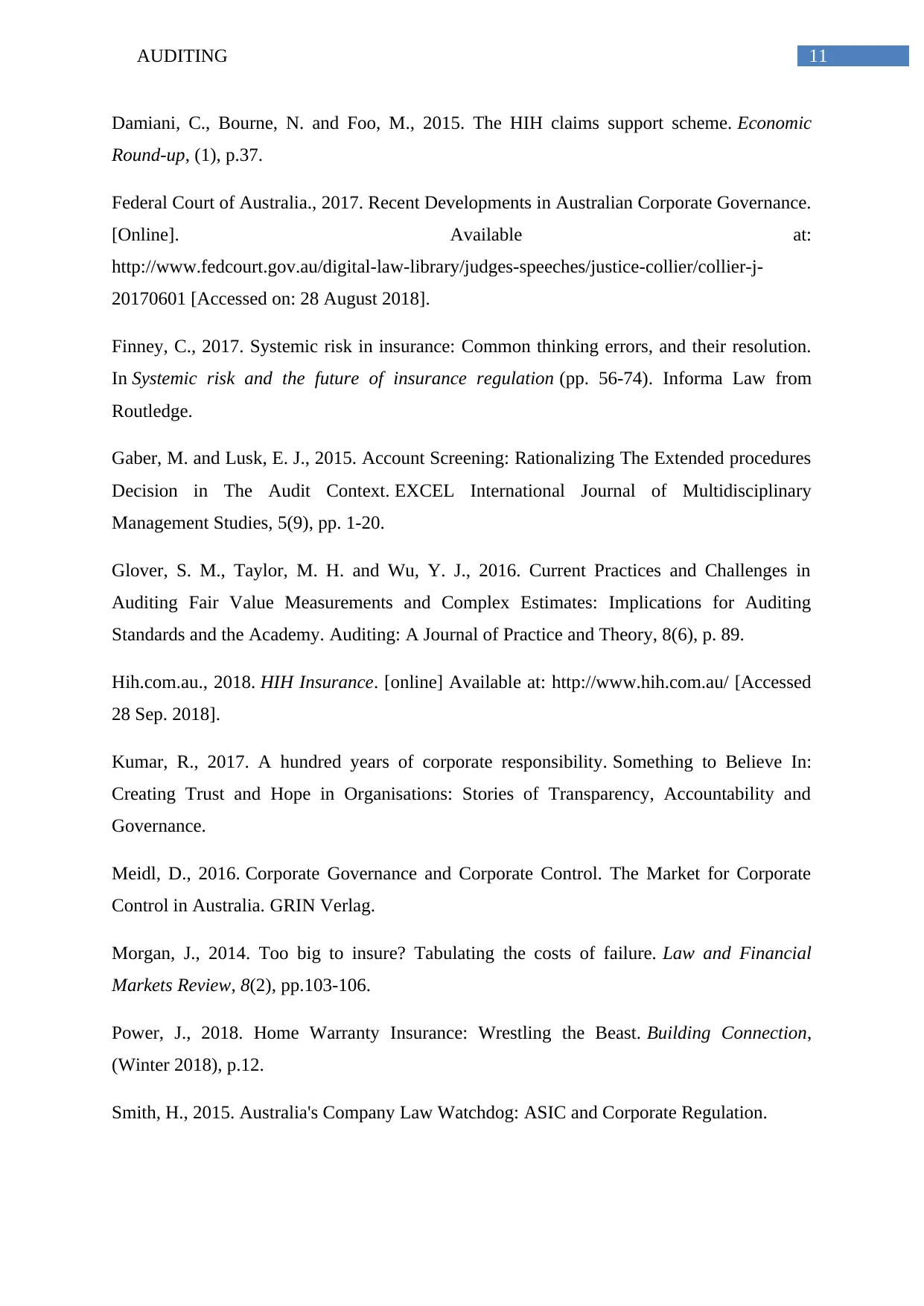
11AUDITING
Damiani, C., Bourne, N. and Foo, M., 2015. The HIH claims support scheme. Economic
Round-up, (1), p.37.
Federal Court of Australia., 2017. Recent Developments in Australian Corporate Governance.
[Online]. Available at:
http://www.fedcourt.gov.au/digital-law-library/judges-speeches/justice-collier/collier-j-
20170601 [Accessed on: 28 August 2018].
Finney, C., 2017. Systemic risk in insurance: Common thinking errors, and their resolution.
In Systemic risk and the future of insurance regulation (pp. 56-74). Informa Law from
Routledge.
Gaber, M. and Lusk, E. J., 2015. Account Screening: Rationalizing The Extended procedures
Decision in The Audit Context. EXCEL International Journal of Multidisciplinary
Management Studies, 5(9), pp. 1-20.
Glover, S. M., Taylor, M. H. and Wu, Y. J., 2016. Current Practices and Challenges in
Auditing Fair Value Measurements and Complex Estimates: Implications for Auditing
Standards and the Academy. Auditing: A Journal of Practice and Theory, 8(6), p. 89.
Hih.com.au., 2018. HIH Insurance. [online] Available at: http://www.hih.com.au/ [Accessed
28 Sep. 2018].
Kumar, R., 2017. A hundred years of corporate responsibility. Something to Believe In:
Creating Trust and Hope in Organisations: Stories of Transparency, Accountability and
Governance.
Meidl, D., 2016. Corporate Governance and Corporate Control. The Market for Corporate
Control in Australia. GRIN Verlag.
Morgan, J., 2014. Too big to insure? Tabulating the costs of failure. Law and Financial
Markets Review, 8(2), pp.103-106.
Power, J., 2018. Home Warranty Insurance: Wrestling the Beast. Building Connection,
(Winter 2018), p.12.
Smith, H., 2015. Australia's Company Law Watchdog: ASIC and Corporate Regulation.
Damiani, C., Bourne, N. and Foo, M., 2015. The HIH claims support scheme. Economic
Round-up, (1), p.37.
Federal Court of Australia., 2017. Recent Developments in Australian Corporate Governance.
[Online]. Available at:
http://www.fedcourt.gov.au/digital-law-library/judges-speeches/justice-collier/collier-j-
20170601 [Accessed on: 28 August 2018].
Finney, C., 2017. Systemic risk in insurance: Common thinking errors, and their resolution.
In Systemic risk and the future of insurance regulation (pp. 56-74). Informa Law from
Routledge.
Gaber, M. and Lusk, E. J., 2015. Account Screening: Rationalizing The Extended procedures
Decision in The Audit Context. EXCEL International Journal of Multidisciplinary
Management Studies, 5(9), pp. 1-20.
Glover, S. M., Taylor, M. H. and Wu, Y. J., 2016. Current Practices and Challenges in
Auditing Fair Value Measurements and Complex Estimates: Implications for Auditing
Standards and the Academy. Auditing: A Journal of Practice and Theory, 8(6), p. 89.
Hih.com.au., 2018. HIH Insurance. [online] Available at: http://www.hih.com.au/ [Accessed
28 Sep. 2018].
Kumar, R., 2017. A hundred years of corporate responsibility. Something to Believe In:
Creating Trust and Hope in Organisations: Stories of Transparency, Accountability and
Governance.
Meidl, D., 2016. Corporate Governance and Corporate Control. The Market for Corporate
Control in Australia. GRIN Verlag.
Morgan, J., 2014. Too big to insure? Tabulating the costs of failure. Law and Financial
Markets Review, 8(2), pp.103-106.
Power, J., 2018. Home Warranty Insurance: Wrestling the Beast. Building Connection,
(Winter 2018), p.12.
Smith, H., 2015. Australia's Company Law Watchdog: ASIC and Corporate Regulation.
⊘ This is a preview!⊘
Do you want full access?
Subscribe today to unlock all pages.

Trusted by 1+ million students worldwide
1 out of 13
Related Documents
Your All-in-One AI-Powered Toolkit for Academic Success.
+13062052269
info@desklib.com
Available 24*7 on WhatsApp / Email
![[object Object]](/_next/static/media/star-bottom.7253800d.svg)
Unlock your academic potential
Copyright © 2020–2025 A2Z Services. All Rights Reserved. Developed and managed by ZUCOL.





